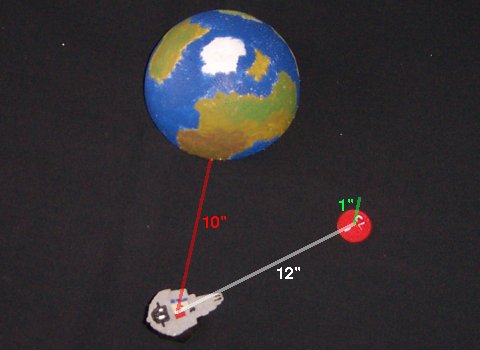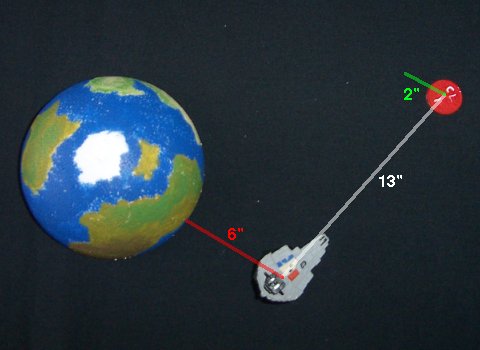This is an old revision of the document!
Gravity
The following rules model gravity from the bottom up, so require a few extra measurements when a ship is manoeuvring close to a planet. Each planet will have a number of gravity zones above its surface (during the game all measurements are taken from the surface of the planet, not it's centre) which dictate the strength of the gravitational field at that point. The radius of these zones increases in a geometric progression - 2“, 4”, 8“, 16” and beyond.
The following are values for some common planets and moons.
| Acceleration at distance from surface | ||||||||||
|---|---|---|---|---|---|---|---|---|---|---|
| Planet | Diameter | 2“ | 4” | 8“ | 16” | 32“ | 64” | 128“ | 256” | 512“ |
| Earth | 13” (12,700km) | 6“ | 4” | 2“ | 1” | – | – | – | – | – |
| The Moon | 3“ (3,475 km) | 0.5” | – | – | – | – | – | – | – | |
| Mercury | 5“ (4,878 km) | 0.5” | – | – | – | – | – | – | – | |
| Venus | 12“ (12,104 km) | 4” | 2“ | 1” | – | – | – | – | – | |
| Mars | 7“ (6,787 km) | 1” | 0.5“ | – | – | – | – | – | – | |
| Jupiter | 142” (142,200 km) | 20“ | 18” | 16“ | 12” | 8“ | 4” | 2“ | 0.5” | |
| Saturn | 119“ (119,300 km) | 9” | 8“ | 6” | 5“ | 3” | 1“ | 0.5” | – | |
| Uranus | 51“ (51,200 km) | 8” | 6“ | 4” | 2“ | 1” | 0.5“ | – | – | |
| Neptune | 49” (49,500 km) | 8“ | 6” | 4“ | 2” | 1“ | – | – | – | |
| The Sun | 1392” (1,392,000 km) | 223“ | 222” | 219“ | 216” | 208“ | 196” | 173“ | 93” | |
| Model | 10“ (10,000km) | 4” | 2“ | 1” | – | – | – | – | – | |
The Effects of Gravity
Every large body, from planets to stars and black holes, will exert gravitational attraction on nearby ships. This attraction will act as an acceleration directly towards the body, just as if the ship were thrusting towards it. Since a thrust of 8 is considered to be equivalent to 1g, so the force of gravity at the surface of an Earth-like world will cause an acceleration of 8“.
Each planet is considered to have gravity bands which reach from its surface out into space. The first band is out to 4”, the second to 8“, the third to 16” - and so on, doubling in distance each time. For an Earth-like world, the gravity in the first 3 bands is 6“/turn, 2”/turn and 1“/turn. This means that any ship that begins a turn within 4” of Earth will get dragged towards the surface by 6“.
The steps to work out the effects of gravity are as follows. We assume that vectored movement is being used, and that a vector marker is used to show each ship's position at the end of the next movement.
At the beginning of movement, work out the distance between the ship and the surface of the planet. If the ship is outside any effective gravity bands for that planet, then the planet has no effect (e.g., outside 16” for an Earth-like world).
Lookup the gravitational acceleration for that planet for that range. There is a table below which lists acceleration values for some common worlds.
Work out the gravity vector from the ship towards the centre of the planet for this acceleration. This vector has a magnitude equal to the acceleration, and a direction pointing to the centre of the planet.
Apply the gravity vector to the ship's vector marker.
Apply any acceleration due to the ship's thrust.
Move the ship and its marker.
It is the distance of the centre of the ship to the surface of the planet that is important - the position of the vector marker has no effect.
Acceleration due to Gravity
The acceleration due to gravity on a ship depends on the size of the planet and the distance the ship is from it. For a planet of Earth size and mass, the following zones of influence are suggested.
| Acceleration at distance from surface | |||||||||
|---|---|---|---|---|---|---|---|---|---|
| Planet | Diameter | 4“ | 8” | 16“ | 32” | 64“ | 128” | 256“ | 512” |
| Earth | 13“ (12,700km) | 6” | 2“ | 1” | – | – | – | – | – |
| The Moon | 3“ (3,475 km) | 0.5” | – | – | – | – | – | – | – |
| Mercury | 5“ (4,878 km) | 0.5” | – | – | – | – | – | – | – |
| Venus | 12“ (12,104 km) | 4” | 2“ | 1” | – | – | – | – | – |
| Mars | 7“ (6,787 km) | 1” | 0.5“ | – | – | – | – | – | – |
| Jupiter | 142” (142,200 km) | 20“ | 18” | 16“ | 12” | 8“ | 4” | 2“ | 0.5” |
| Saturn | 119“ (119,300 km) | 9” | 8“ | 6” | 5“ | 3” | 1“ | 0.5” | – |
| Uranus | 51“ (51,200 km) | 8” | 6“ | 4” | 2“ | 1” | 0.5“ | – | – |
| Neptune | 49” (49,500 km) | 8“ | 6” | 4“ | 2” | 1“ | – | – | – |
| The Sun | 1392” (1,392,000 km) | 223“ | 222” | 219“ | 216” | 208“ | 196” | 173“ | 93” |
| Model | 10“ (10,000km) | 4” | 2“ | 1” | – | – | – | – | – |
Remember that the distances given above are the distance from the surface of the body. The Sun will not fit into any sensible gaming area, and is given merely to show how insignificant everything else is. Even Jupiter would require at least 2.5m (at centimetre scales) to allow for manoeuvring at the edge of its gravity well.
Where acceleration less than 1“ is given, it can be ignored. However, this does mean that small worlds such as Mercury would have no effect, so it's listed anyway in case you want to use it.
Examples
Fast Fly-by
The following example shows the Light Cruiser Colbert approaching a planet. At no point does the Colbert apply any thrust of its own. The world is slightly smaller than the Earth, with statistics as follows:
| Acceleration at distance from surface | |||||
|---|---|---|---|---|---|
| Planet | Diameter | 4” | 8“ | 16” | 32“ |
| Model | 10” (10,000km) | 4“ | 2” | 1“ | – |
We begin the example with the Colbert 10,000 km (10”) from the planet's surface. The Colbert has a current velocity of 12“/turn (as denoted by the red vector marker in the diagram).
The gravitational acceleration at this point is 1”/turn, in a direction about 45 degrees to the Colbert's current heading. This acceleration is applied to the vector marker (vector shown in green above).
This moves the Colbert to its new location, somewhat closer to the planet but halfway around it.
At the new distance of 6“ (shown in red), the gravitational acceleration is 2”/turn. Again this is applied to the vector marker. Note that the marker is moved in the direction that the Colbert would be moved by gravity.


